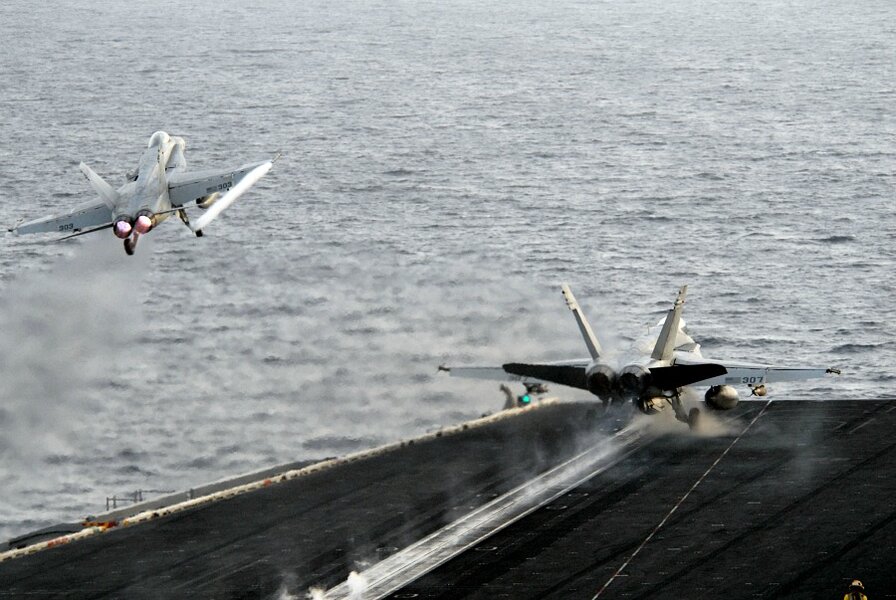Two Navy jets crash into Pacific: Was mid-air collision to blame?
Loading...
US Navy officials have yet to report what caused two F/A-18 fighter jets to crash into the Pacific Thursday afternoon.
But given the known circumstances about the training flight involving two Hornet fighters some 300 miles west of Wake Island in the western Pacific, which occurred at about 5:40 p.m. local time, unofficial reporting points to a mid-air collision.
One pilot ejected from his aircraft and was quickly recovered by rescue helicopter and returned to the aircraft carrier USS Carl Vinson, where he received medical treatment and was reported to be in fair condition. Following a night search that continued into Friday, the pilot of the other aircraft had not been located. Neither aircraft was recovered.
According to the Navy’s brief announcement, the search for the second pilot includes guided-missile cruiser USS Bunker Hill and guided-missile destroyer USS Gridley and helicopters assigned to Helicopter Sea Combat Squadron and Helicopter Maritime Strike Squadron.
Based on information from unnamed Navy officials, the US Naval Institute, a private, nonprofit military association, reported Friday that the loss of the two aircraft occurred “following a mid-air collision.” NBC News also reported that a mid-air collision caused the crash.
Assigned to the US 7th Fleet, the USS Carl Vinson and Carrier Air Wing 17 left Naval Station Coronado, Calif., on Aug. 22 for a nine-month deployment. The F/A-18C jets were from two squadrons based at Naval Air Station Lemoore in California's San Joaquin Valley.
The carrier is in the vicinity of Guam in support of Exercise Valiant Shield 2014. The 180,000 troop exercise includes elements of the Army, Navy, Air Force, and Marine Corps. The exercise starts on Monday and will run until Sept. 23.
The Carl Vinson, named for the late congressman from Georgia, is headed for the Persian Gulf to relieve the aircraft carrier USS George H.W. Bush, which has been launching combat missions over Iraq. Launched in 1980, the nuclear-powered Carl Vinson was the third US Navy Nimitz-class super carrier.
The F/A-18C is a twin-engine, single-seat strike fighter, designed to function both as a fighter engaging enemy aircraft and as an attack aircraft bombing ground targets. Fifty-six feet long and with a wingspan of 40½ feet, Hornet C models have been deployed since the late 1980s.
Built by prime contractor McDonnell Douglas, the jets are capable of flying at speeds greater than Mach 1.7 and altitudes of more than 50,000 feet, according to the Navy. It is flown by the Blue Angels, the Navy’s flight demonstration team.
In March, a US Marine Corps F/A-18C crashed at a Nevada bombing range, killing the pilot. An F/A-18E Super Hornet crashed in June as it prepared to land on the Carl Vinson off the Southern California coast. The pilot was able to eject safely.
In April, 2012, a two-seat Navy F/A-18D experienced a mechanical failure and crashed in Virginia Beach, Va., shortly after take-off, damaging or destroying some 40 apartment units. In what was described at the time as a “Good Friday miracle,” seven people were injured, but none seriously – including the two pilots, who barely made it out of their stricken aircraft before it became a fireball.
The report includes material from the Associated Press.








